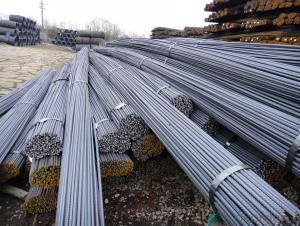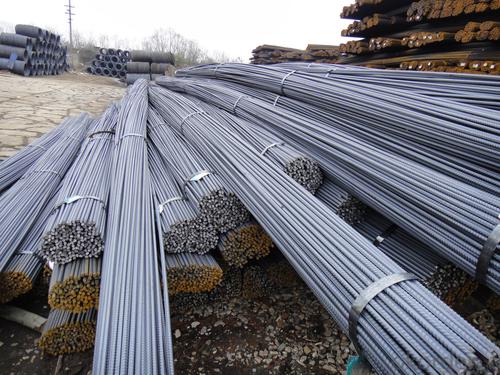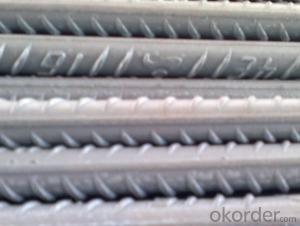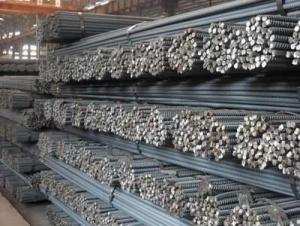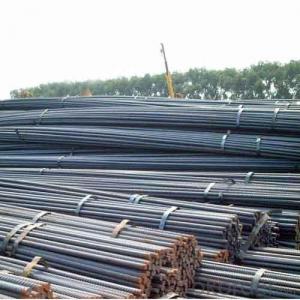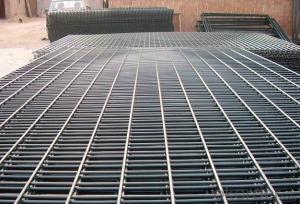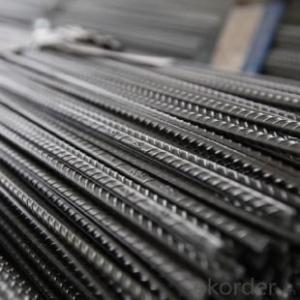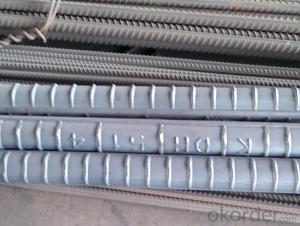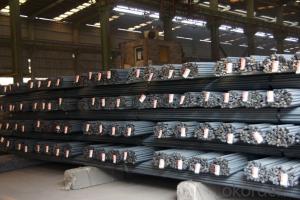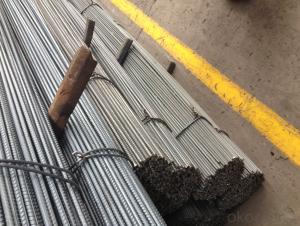High Quality Steel Deformed Bar HRB400 12/14/16mm
- Loading Port:
- Tianjin
- Payment Terms:
- TT or LC
- Min Order Qty:
- 50 m.t
- Supply Capability:
- 10000 m.t/month
OKorder Service Pledge
OKorder Financial Service
You Might Also Like
High Quality Steel Deformed Bar HRB400 12/14/16mm
Product Description:
Specifications of High Quality Steel Deformed Bar HRB400 12/14/16mm:
Standard | GB | HRB400 | |
Diameter | 12mm,14mm,16mm | ||
Length | 6M, 9M,12M or as required | ||
Place of origin | Hebei, China mainland | ||
Advantages | exact size, regular package, chemical and mechanical properties are stable. | ||
Type | Hot rolled deformed steel bar | ||
Chemical Composition of High Quality Steel Deformed Bar HRB400 12/14/16mm: (Please kindly find our chemistry of our material based on HRB400 as below for your information)
Grade | Technical data of the original chemical composition (%) | ||||||
C | Mn | Si | S | P | V | ||
HRB400 | ≤0.25 | ≤1.60 | ≤0.80 | ≤0.045 | ≤0.045 | 0.04-0.12 | |
Physical capability | |||||||
Yield Strength (N/cm²) | Tensile Strength (N/cm²) | Elongation (%) | |||||
≥400 | ≥570 | ≥14 | |||||
Theoretical weight and section area of High Quality Steel Deformed Bar HRB400 12/14/16mm as below for your information:
Diameter(mm) | Section area (mm²) | Mass(kg/m) | Weight of 12m bar(kg) |
12 | 113.1 | 0.888 | 10.656 |
14 | 153.9 | 1.21 | 14.52 |
16 | 201.1 | 1.58 | 18.96 |
Usage and Applications of High Quality Steel Deformed Bar HRB400 12/14/16mm:
Deformed bar is widely used in buildings, bridges, roads and other engineering construction. Big to highways, railways, bridges, culverts, tunnels, public facilities such as flood control, dam, small to housing construction, beam, column, wall and the foundation of the plate, deformed bar is an integral structure material. With the development of world economy and the vigorous development of infrastructure construction, real estate, the demand for deformed bar will be larger and larger.
Packaging & Delivery of High Quality Steel Deformed Bar HRB400 12/14/16mm:
Packaging Detail: products are packed in bundle and then shipped by container or bulk vessel, deformed bar is usually naked strapping delivery, when storing, please pay attention to moisture proof. The performance of rust will produce adverse effect.
Each bundle weight: 2-3MT, or as required
Payment term: TT or L/C
Delivery Detail: within 45 days after received advanced payment or LC.
Label: to be specified by customer, generally, each bundle has 1-2 labels
Trade terms: FOB, CFR, CIF
FAQ:
Q1: Why buy Materials & Equipment from OKorder.com?
A1: All products offered byOKorder.com are carefully selected from China's most reliable manufacturing enterprises. Through its ISO certifications, OKorder.com adheres to the highest standards and a commitment to supply chain safety and customer satisfaction.
Q2: How do we guarantee the quality of our products?
A2: We have established an advanced quality management system which conducts strict quality tests at every step, from raw materials to the final product. At the same time, we provide extensive follow-up service assurances as required.
Q3: How soon can we receive the product after purchase?
A3: Within three days of placing an order, we will arrange production. The shipping date is dependent upon the quatity, how many sizes you want and the plan of production, but is typically 1 month to 2 month days from the beginning of production.
Images of High Quality Steel Deformed Bar HRB400 12/14/16mm:
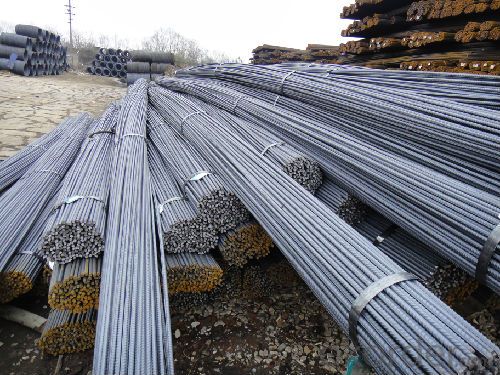
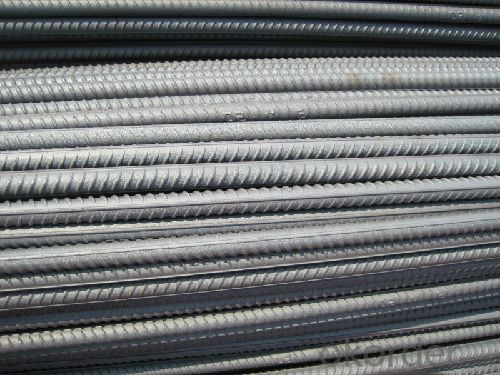
*If you would like to get our price, please inform us the size, standard/material and quantity. Thank you very much for your attention.
- Q: What are the common sizes of steel rebars used in construction?
- The common sizes of steel rebars used in construction vary depending on the specific application and engineering requirements. However, there are several standard sizes that are commonly used in the industry. The most frequently used rebar sizes range from #3 to #18. These numbers represent the diameter of the rebar in eighths of an inch. For example, a #3 rebar has a diameter of 3/8 inch, while a #18 rebar has a diameter of 2 1/4 inches. In terms of metric measurements, the most common rebar sizes range from 10mm to 40mm in diameter. These sizes are often designated by their nominal diameter in millimeters, such as 10mm, 12mm, 16mm, 20mm, 25mm, 32mm, and 40mm. The selection of the appropriate rebar size depends on factors such as the load-bearing capacity required, the structural design, and the type of construction project. Smaller diameter rebars, like #3 or 10mm, are typically used in lighter construction projects or for smaller concrete elements such as walls or slabs. On the other hand, larger diameter rebars, like #18 or 40mm, are commonly used in heavy-duty applications such as bridges, high-rise buildings, or large-scale infrastructure projects. It is important to note that different countries or regions may have their own specific standards for rebar sizes, so it is crucial to consult local building codes and regulations to ensure compliance.
- Q: How do steel rebars contribute to the ductility of reinforced concrete structures?
- The ductility of reinforced concrete structures is enhanced by steel rebars which serve multiple purposes. Firstly, by resisting tensile forces, the rebars prevent the concrete from cracking or failing under tension. This allows the structure to deform and absorb energy without catastrophic failure. Secondly, the rebars distribute applied loads across a wider area, reducing localized concentrations and promoting flexibility and energy absorption. Additionally, the rebars provide anchorage and confinement to the concrete, preventing slippage and expansion under tension. In conclusion, steel rebars contribute to the overall ductility of reinforced concrete structures by providing tensile strength, stress redistribution, and anchorage and confinement capabilities.
- Q: What are the different types of steel rebars used in road constructions?
- There are several types of steel rebars that are commonly used in road constructions. These include: 1. Mild steel rebars: These are the most commonly used type of rebars in road constructions. They are made from low carbon steel and have a smooth surface. Mild steel rebars are known for their durability and strength, making them suitable for various road construction applications. 2. High-strength rebars: These rebars are made from high-strength steel, which has a higher yield strength compared to mild steel rebars. High-strength rebars are used in road constructions where greater load-bearing capacity is required, such as in bridges and highways. 3. Epoxy-coated rebars: These rebars are coated with epoxy resin to improve their corrosion resistance. Epoxy-coated rebars are commonly used in road constructions in areas where there is exposure to moisture and chemicals, such as coastal regions. 4. Galvanized rebars: These rebars are coated with a layer of zinc to provide corrosion resistance. Galvanized rebars are particularly suitable for road constructions in areas with high humidity or where the risk of corrosion is high. 5. Stainless steel rebars: These rebars are made from stainless steel, which is highly resistant to corrosion. Stainless steel rebars are commonly used in road constructions where long-term durability and resistance to corrosion are essential, such as in tunnels and underground structures. It is important to select the appropriate type of steel rebar for road constructions based on the specific requirements of the project, including load-bearing capacity, exposure to corrosion, and environmental conditions. Consulting with structural engineers and adhering to local construction codes and standards is crucial to ensure the successful implementation of road construction projects.
- Q: What is the maximum diameter of steel rebars available in the market?
- The maximum diameter of steel rebars available in the market can vary, but typically it ranges from 40mm to 50mm.
- Q: How do steel rebars contribute to the crack control in slabs and walls?
- Steel rebars contribute to crack control in slabs and walls through their ability to resist tensile forces. When concrete slabs and walls experience loads, such as the weight of the structure or external forces, they may develop tensile stresses. Concrete is strong in compression but weak in tension, making it prone to cracking under tensile forces. Steel rebars are embedded within the concrete to counteract these tensile stresses. By absorbing and distributing the tensile forces, rebars help to prevent crack formation and control their propagation. The rebars act as reinforcement, increasing the overall tensile strength of the concrete. The presence of steel rebars in slabs and walls helps to limit the width and length of cracks that may occur by providing resistance against the tensile stresses. This crack control is crucial for maintaining the structural integrity and durability of the concrete elements. Furthermore, steel rebars can also contribute to crack control by improving the overall ductility of the structure. Ductility refers to the ability of a material to deform under load without fracturing. By enhancing the ductility of the concrete, the rebars allow the structure to absorb energy and deform in a controlled manner, reducing the likelihood of sudden failure or catastrophic collapse. In summary, steel rebars play a vital role in crack control in slabs and walls by increasing the tensile strength of concrete, limiting crack width and length, and improving overall structural ductility. Their presence ensures the long-term durability and safety of these concrete elements.
- Q: How are steel rebars measured?
- The standardized system known as the "bar size number" is utilized to measure steel rebars. Each rebar size is assigned a numerical value, which corresponds to its diameter. The diameter is measured in inches or millimeters, depending on the region or country. In the United States, the bar size number ranges from #3 to #18 and indicates the diameter in eighths of an inch. For example, a #3 rebar has a diameter of 3/8 inch, while a #8 rebar has a diameter of 1 inch. Beyond #8, the diameter is measured in quarters of an inch. A #11 rebar, for instance, has a diameter of 1 1/8 inches, and a #18 rebar has a diameter of 2 1/4 inches. In metric countries, millimeters are used to measure rebars. The diameter is usually rounded to the nearest millimeter. For instance, a 10 mm rebar is equivalent to a #3 rebar in the US, and a 25 mm rebar is equivalent to a #8 rebar. To determine the length of a rebar, a tape measure or ruler is employed. The length is typically measured in feet or meters. Rebars are commonly available in 20 or 40 feet (6 or 12 meters) lengths, but they can also be cut to custom lengths as per project requirements. It is important to note that the measurement system may vary slightly in different regions or countries. Therefore, it is crucial to consult local standards and codes for accurate measurement guidelines.
- Q: How long do steel rebars typically last in a building?
- Steel rebars typically last for the lifetime of a building, which can be several decades or even centuries, depending on factors such as the quality of the rebar, the environment it is exposed to, and proper maintenance practices.
- Q: What is the standard size of a steel rebar?
- The standard size of a steel rebar typically ranges from 6mm to 50mm in diameter.
- Q: Can steel rebars be used in foundation repair work?
- Yes, steel rebars can be used in foundation repair work. They are commonly used to reinforce concrete foundations, providing added strength and stability to the structure. Steel rebars help prevent cracks and structural damage in the foundation, making them an essential component in foundation repair projects.
- Q: How do steel rebars affect the overall creep and shrinkage of concrete structures?
- Steel rebars can have a significant impact on the overall creep and shrinkage of concrete structures. Creep refers to the long-term deformation of concrete under sustained load, while shrinkage is the reduction in volume that occurs as the concrete dries and hardens. Steel rebars play a crucial role in controlling and mitigating both creep and shrinkage. When embedded in concrete, rebars provide tensile strength and improve the overall load-carrying capacity of the structure. This reinforcement allows for the distribution of stress and helps limit the amount of deformation that occurs over time. In terms of creep, steel rebars help minimize its effects by reducing the amount of stress transferred to the concrete. By absorbing a significant portion of the applied load, rebars alleviate the strain on the concrete, thus reducing the creep deformation. Additionally, the presence of rebars helps control the cracking that may occur due to creep, further preserving the structural integrity of the concrete. Regarding shrinkage, steel rebars can also influence its magnitude. As concrete shrinks during the drying and hardening process, the rebars act as restraints, preventing excessive volume reduction. By resisting the contraction forces, rebars help minimize the potential for cracking and maintain the structural stability of the concrete. It is important to note that the choice of rebar type, size, and spacing can affect the overall impact on creep and shrinkage. Proper design and placement of rebars, including appropriate cover thickness, are necessary to ensure optimum performance and minimize the potential for long-term deformations. In summary, steel rebars play a vital role in controlling the overall creep and shrinkage of concrete structures. By providing reinforcement and distributing stress, rebars help limit deformation, prevent cracking, and maintain the structural integrity of the concrete over time.
Send your message to us
High Quality Steel Deformed Bar HRB400 12/14/16mm
- Loading Port:
- Tianjin
- Payment Terms:
- TT or LC
- Min Order Qty:
- 50 m.t
- Supply Capability:
- 10000 m.t/month
OKorder Service Pledge
OKorder Financial Service
Similar products
Hot products
Hot Searches
Related keywords
